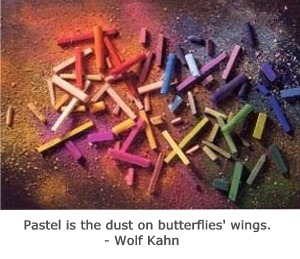|
 'Pastels'
consist of pure pigments mixed with a little binder and
compressed into sticks. Because of their purity,
pastels have a brilliance of color that is unequaled by other
mediums, such as oil paints and watercolors. To the
untrained eye, a pastel stick looks similar to a colored piece of
chalk - but don't insult a pastelist by referring to their
medium by that name! There is simply no comparison between
chalk and the rich, lustrous hues achieved with good-quality soft
pastels. 'Pastels'
consist of pure pigments mixed with a little binder and
compressed into sticks. Because of their purity,
pastels have a brilliance of color that is unequaled by other
mediums, such as oil paints and watercolors. To the
untrained eye, a pastel stick looks similar to a colored piece of
chalk - but don't insult a pastelist by referring to their
medium by that name! There is simply no comparison between
chalk and the rich, lustrous hues achieved with good-quality soft
pastels. Pastels
- which are sometimes called 'soft' or 'dry' pastels - are very
different from a similar medium called 'oil pastels'. Oil
pastels are pigment mixed with a little oil and/or wax to create
a stick much like an upscale crayon. The best oil pastels
may feel like applying lipstick. A pastelist may
work in either type of pastel, but usually the term 'pastels'
refers to soft pastels.
In
creating a painting, pastels are applied to paper or another
'support' - and there are a great number of products to choose
from. A pastelist is often interested in how much 'tooth'
the paper has, as that is what 'grabs' the pastel so that it can
adhere to the paper. The more 'tooth', the more layers of
pastel can be applied before the paper won't hold any
more. Consequently, papers created specifically for
pastels tend to be highly textured. Some are very much
like fine-grit sandpaper because that has the capacity to hold a
lot of dry pigment. Unlike
paint, pastelists can't mix the color they need from a few tubes
of primary colors. Instead, the pastelist must already have
the color they need in the form of a pastel stick. Accomplished pastelists may have thousands of pastel
sticks. They also become 'experts' at mixing colors
right on the paper. Good 'tooth' allows the pastelist to
create layers of colors that the viewer's eye mixes into the
color the artist desires for them to see. These layers of
color give the painting a rich and intriguing surface. The
'look' of a pastel painting is often due to the type of paper and
the hardness or softness of the pastel sticks that are
used. Some pastels are so soft that they literally crumble
to your feet while you're working with them. But, softness
is desirable to some artists, as that allows them to create
luscious strokes within the piece. Pastels
have become increasingly popular in recent years and have
attracted many artists who work in other mediums. Those who like
to draw often find pastels to be ideal, as they allow the artist
to draw while using expressive color and strokes. By breaking a
stick in half, artists can also achieve coverage and strokes
similar to what you'd find in a painting. Because
of this, pastels are no longer regarded as simply a 'drawing' medium.
'Painting' with pastels is
now a popular concept, and many artists are specializing in
it. Most pastelists appreciate the 'hands on' quality of
pastels. Not having a brush to manipulate often results in
a very intuitive and expressive work of art.
Framing
and Displaying Pastels Because
pastel paintings are fragile, they need special framing to
protect them. All it takes is one accidental swipe and the
painting can be ruined. Once properly framed, they will keep their brilliant
beauty for generations. It's important that pastels be
framed with glass (instead of plexi-glass) to minimize static, and
that the glass be kept away from the
painting. The surface of a pastel painting is actually
three dimensional. Because they stand out from the surface,
the flecks of pastel pigment capture the light and 'glow' - thus
increasing the painting's brilliance. Framing a valuable pastel is usually not a do-it-yourself project,
even for experienced framers. If your pastel painting needs
a different frame, it will be worth your while - and the
painting's safety - to find a
framer who is experienced with handling pastels. Teresa's
paintings are framed with a hidden spacer behind the bottom mat
so that dislodged pastel dust can fall behind the mat. This
keeps the mat clean so that the painting always looks good.
When transporting
pastel paintings, it's best if they remain flat or tipped
backward so that any dust that is shaken loose can slide behind the bottom
mat. As
with any fine art, hang your pastel painting away from direct sunlight. Over time, the sun's rays can cause fading.
|